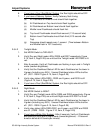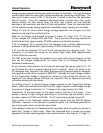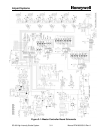
Airport Systems
SG-60 High Intensity Strobe System 3-5 Manual EPM-00000019 Rev A
position is shown on the board silkscreen. Note that ON means zero, and that OFF
means the indicated value (negative binary).
The Digital Board will only transmit a reply when its number is specified by the Master
Controller.
The Digital Board monitors its transmission quality by reading the transmission as it
sends it. The green LED DS3 indicates the current communications status. It is
updated after every flash. If no valid requests are being received from the Master
Controller, the LED will stay off. If DS3 comes on, this indicates a valid data reception
from the Master Controller. The DS3 flash pattern indicates the status of the most
recent transmission from this Flashhead to the Master Controller. A "slow blink"
indicates that no transmission has been attempted yet (status unknown). A "steady on"
state indicates that the most recent transmission read back correctly. A "fast blink"
indicates that most recent transmission failed to read back correctly.
The normal cycle on power up is: DS3 Off, then slow blink, then steady on. The
duration of the "slow blink" period depends on the number of Flashheads in the system,
as the Master Controller queries them in numeric order.
The Digital Board expects the Master Controller to request every flash. If the request
does not arrive when expected, the DS3 will go out, and the DS3 status cycle will start
over (transmission status will start as unknown).
If no flash requests are received from the Master Controller for 4 consecutive flash
periods, the Digital Board considers that there has been a communications failure. If it
has been at least 12 hours since power-on, it will use the power down circuit to reset
itself. Otherwise it will switch the strobe to Day Mode.
For a Dual System, when the white lights are not flashing (at night), the Master
Controller is still broadcasting regular flash requests -- but is requesting that the strobe
flash in the "Off Mode."
3.2.2.3 Mode Selection
If the Local/Remote switch is open (the spring-back position after being pushed in), the
Digital Board will operate the strobe according to the position it reads in the Mode
Select Switch. If the Local/Remote switch is closed (pushed in or pulled all the way
out), the Digital Board operates the Flashhead in the mode requested by the Master
Controller.
When the Master Controller requests a change in mode, there will be a 4-flash delay
before the Flashheads update own remote mode selection to match the requested
mode.
If the SW2-3 (NO NITE) is set ON, the Digital Board will not flash at all in night mode.
This option is provided for backward compatibility with Dual Systems with older Master
Controllers installed that can not broadcast an "Off" mode. In these older systems the
flashheads were configure the flashheads to not flash at night, when the Red Lights
were switched on. This option should not be used with the Master Controller described
in this manual. Instead, configure the Master Controller to work with a Dual System.


















